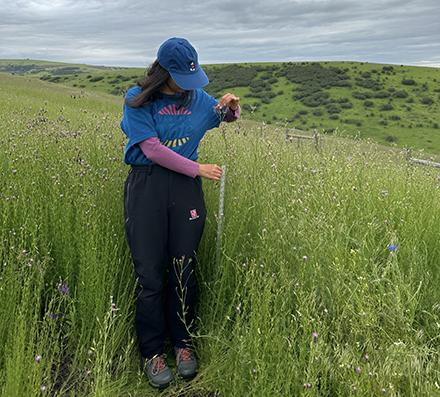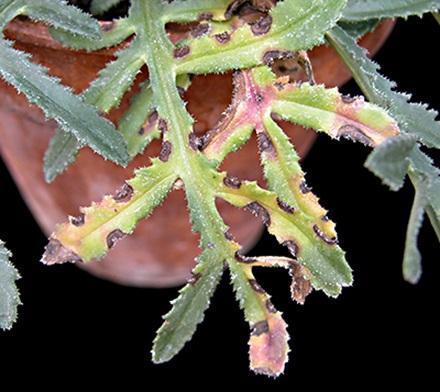ARS Teams With Native American Communities to Manage Invasive Weeds

Height and density of common crupina. (Photo courtesy of Matthew Tancos, ARS)
They compete with crops, reduce forage, and harm livestock. They fuel wildfires, clog waterways, harbor crop pests, and produce allergens and toxins that are harmful to animal and human health. They damage local environmental systems and cost billions of dollars to try to manage. They are invasive weeds.
Dozens of weeds in the United States are classified as invasive or noxious, some more dangerous than others. In the case of common crupina (Crupina vulgaris), the weed is not toxic but is avoided by most grazing livestock, which means the weed can readily take over large areas cleared by livestock grazing on native plants. Conservative estimates indicate common crupina has overtaken large portions of Western states, covering more than 25,000 hectares (nearly 62,000 acres) in Idaho, California, Oregon, Washington.
Conventional weed management practices – including herbicides, hand pulling, heat treatment, and reseeding – have largely been unsuccessful. Now, however, scientists from the Agricultural Research Service (ARS) are bringing biocontrol methods to bear.
According to Matthew Tancos, plant pathologist at the Agricultural Research Service’s (ARS) Foreign Disease-Weed Science Research Unit at Frederick, MD, biocontrol is a pest management strategy that uses biological organisms to manage a targeted pest. Usually that involves using natural enemies (pests or pathogens) to help control an invasive species and when paired with other tactics, like grazing or herbicides, can be even more effective and sustainable.
Tancos noted that plant pathogens are unique natural enemies that should be exploited because they can be highly host-specific and effective. In this case, the pathogen is a leaf spotting fungus called Ramularia crupinae. R. crupinae was identified in the late 1990s in southern Europe, and field studies demonstrated it to be very effective in France.

The effects of Ramularia crupinae, a biological control agent of common crupina. (Photo courtesy of Matthew Tancos, ARS)
ARS researchers evaluated the pathogen at a research facility in Fort Detrick, MD. The ARS Foreign Disease-Weed Science Research unit is a secure, high-level containment facility where researchers tested the fungus against several diverse plant species that are related to common crupina, including crops, ornamentals, native, and endangered/threatened plant species.
They demonstrated that R. crupinae was a prime candidate for the management of common crupina populations in the United States due to its host specificity (its singular preference to infect a particular host) and ability to impact the weed’s growth and seed production. The fungus infects the leaves and stems of the plant, resulting in disease and reduced plant growth.
A study by former ARS scientist W. L. Bruckart showed that common crupina produced 47% less root weight and experienced a 39% reduction in seed production after inoculation with R. crupinae.
While that success rate is impressive, it’s even more significant on the lands of ARS’s project research partners – the Nez Perce Tribe (NPT) and the Confederated Tribes of the Umatilla Indian Reservation (CTUIR).
“Common crupina infests large acreage of Native American land in the Western United States,” Tancos said. “Within Idaho and Oregon, the CTUIR and NPT both want to preserve native plant communities, support tribal growers, and encourage the restoration of ‘First Foods’ (culturally important plants).”
Both tribal communities actively implement invasive species management projects and actively look for new opportunities to manage invasive plants.
“Through these local tribal community interactions, we hope to support community-wide interest in managing non-native invasive weeds,” Tancos said. “Decreasing common crupina populations will directly benefit tribal agriculture by increasing rangeland forage productivity and livestock carrying capacity, preserve native and beneficial plant communities, prevent the displacement of rare and threatened species, and reduce the funds and resources necessary to maintain long-term common crupina management operations.”
Tancos said that complete management of a weed is difficult once it achieves the official status of “invasive,” noting that the goal of biological control is not eradication, but population management and reducing the agricultural and/or ecological impact of the invasive species.
“Our field studies are too early to make any predictions, but we were greatly excited to see disease development at all research sites following the release of the fungus,” Tancos said. “This was a critical first step since this fungus is not from these unique regions, and as with any biological organism, is highly dependent on the environment.” – by Scott Elliott, ARS Office of Communications

